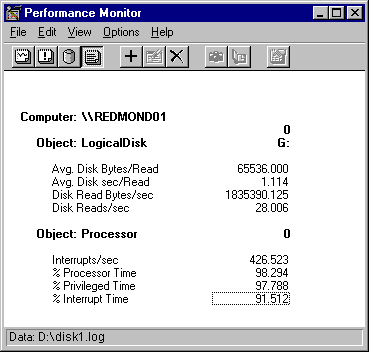
Just as a memory shortage can look like a disk problem, a disk bottleneck can look like a processor problem. This happens when the rate of interrupts caused by disk activity consume the processor. Although different disk components use different strategies for transferring data to and from the disk, they all use the processor to some extent. You can measure the effect of the disk on the processor by charting
There is a lot of activity other than disk operations that produce processor interrupts, even on a relatively idle system. To determine the number of processor interrupts attributable to disk activity, you need to subtract from your measurements those attributable to other causes. On an Intel 486 or later processor, the processor clock interrupts every 10 milliseconds, or 100 times per second. Network interrupts can produce 200–1000 interrupts/sec. Also, hardware errors, like failing drivers, can produce thousands of interrupts.
The following report shows an example of interrupts during a maximum throughput test on a controller that uses programmed I/O, a disk transfer method that uses the processor to tell the drive what sectors to read. The computer was disconnected from the network during the test.

In this example, there were an average of 426.5 interrupts per second. Subtracting 100 per second for the system clock leaves 326.5 from the disk activity, or 76.5% of interrupts. The processor was 98.3% busy on average, and 97.8% of it was in privileged mode, where interrupts are serviced. On average, 91.5% of processor time was consumed by interrupts. Since the disk was responsible for 76.5% of interrupts, it is likely to have generated about 70% of processor use (76.5% of 91.5%). This is substantial and, if sustained, could slow the whole system.